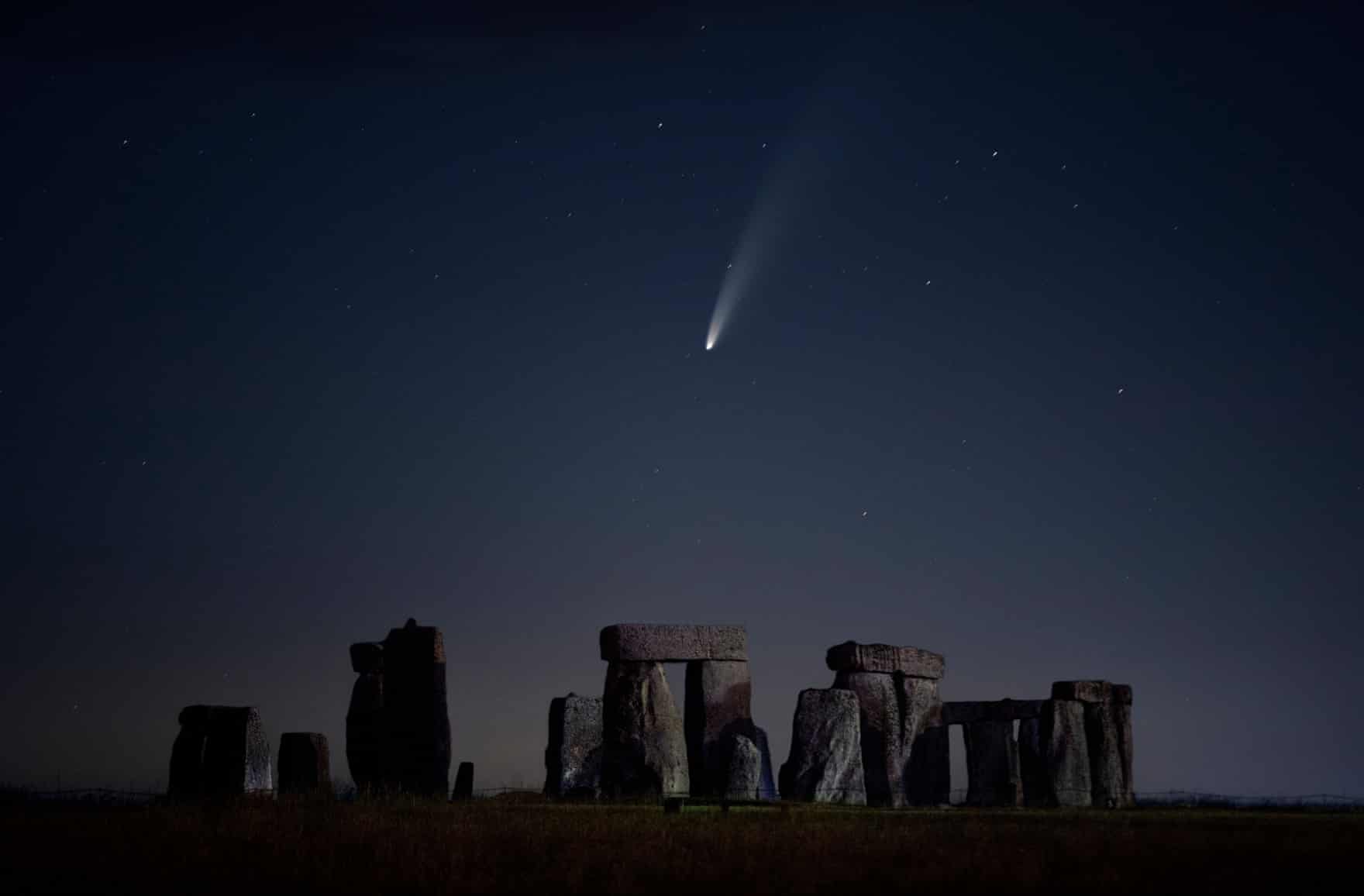Notes

Photo: Mark Kerton/ Rex/ Shutterstock. Caption: Neowise passes over Stonehenge in Wiltshire, England, on 12 July, 2020.
With All Our Troubles, Comet NEOWISE Offers Timely Perspective
Could the comet be a sign? Only coming around every 6,800 years, perhaps NEOWISE has some lessons to offer about history, humility, and introspection.
By Edward Brydon
The presence of Comet NEOWISE in the night sky has many of us gazing upwards at night, away from our screens and the daily news. Comets have long held significance for people. It would perhaps be no surprise if even now, when we understand more through science than our ancestors could explain, that we are still looking for celestial signs.
The comet, discovered by NASA’s Near-Earth Object Wide-field Infrared Survey Explorer (NEOWISE) on March 27, 2020, was visible to the naked eye from roughly July 1st for some observers, until the last few days of July. It will not return for another 6,800 years. According to scientists at NASA Jet Propulsion Laboratory (JPL), it is about 3 miles across and is covered with sooty, dark particles left over from its formation near the birth of our solar system 4.6 billion years ago. Like almost all comets it has two tails, one made of dust particles and a blueish ion tail comprised of vaporizing ice.
Photographs of Comet NEOWISE (also known as Comet C/2020 F3) have flooded news media, social media, and astro-photography sites over the last two weeks. But the image that stands out most is the scene of it glowing above Stonehenge in England. Here, it takes on a quasi-religious mantel, shining brightly over a structure that may have been a site of pagan ritual in pre-historic Britain, the kind of heavenly sign that the people may have responded to in those times. The first structures of Stonehenge were put in place after NEOWISE last appeared, about 5,000 years ago, prompting the question; what was happening in the world the last time humans saw NEOWISE?
A comet as a portent of our current days, especially with the flood of negative news around the world, is an interpretation that is hard to resist. Positive and negative associations have long been ascribed to comets. Famously, Halley’s Comet appeared before the Battle of Hastings in 1066, when King Harold of England was defeated by King William of Normandy, earning the latter a sobriquet, “The Conqueror.” This was the last time England was successfully invaded and, as such, the notion of a comet as a bad omen might be hard to shake for people there, even now. However, if viewed from the Norman side, the comet may have been a portent of victory, not doom.
This notion of looking backward and forward in time is itself projected by NEOWISE, which appears as a stellar metronome every 6,800 years. The beats of NEOWISE bring us closer to the concept of deep time and how much changes for humanity between each appearance. Early humans understood this concept already, perhaps as far back as 40,000 years ago. In 2018, researchers studying cave paintings and comparing them with astrological phenomena found that rather than depicting scenes of hunts, early humans may have been charting time. The animals and events depicted in the cave paintings represent star constellations and from these drawings, it seems early humans had learned that there are shifts in the rotational axis of the earth, known as precession.
This procession of time brings home that our lives, indeed the span of humans on Earth, is but a speck in the time of the universe. Thinking about this can provoke introspection, as much of the world is already currently looking inward. In part, this is due to the COVID-19 pandemic, which has forced us into isolation, slowing time down and leaving us alone with our thoughts despite technology that allows us to live at a faster pace in a world more connected than ever.
With the confluence of so many explosive events in our world, nationalism and isolationism gaining footholds, and societies reckoning with racism, hatred and erosion of freedoms, it seems uncanny that the comet has also now appeared before us, newly (re)discovered, after so long. What might this mean? The tail stretched out behind NEOWISE trails upward in our sky, giving it the appearance of a downward trajectory on a collision course with Earth. Though NEOWISE will not impact Earth, at least two comet strikes have been featured in cave paintings the researchers studied; one can be found in the famous Lascaux shaft scene dating to 15,200 B.C. while another drawn at Gobekli Tepe in modern Turkey dates to 11,000 B.C.
We don’t ever know the outcome of history while we’re living through it. The swirling, portentous events around the world are, rightly, vitally important to all of us. But in the grander scheme of the lifespan of the Earth and the Universe, they are not. NEOWISE will not show itself in our skies again for another 6,800 years—where and what will Earth be then? One thing is for sure: by then we will all have become dust and vapor, much like the comet’s tails, streaking away from the lives we once held dear, fading in time and memory. Looking up at a comet bearing down on us in the vastness of the night sky, we might—for a moment—sense our own place and gain a sense of humility.


Reactions
Comments Powered by Disqus